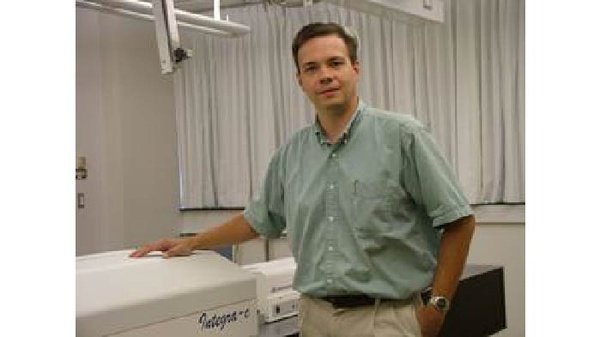Not Just for Looks: New Gold Mirrors Aid Investigation of Chemical Separations
Dec. 6, 2011

Take a paper towel and dip the edge into water that is laced with colored dye. As the thin fibers of the towel soak up the mixture, the water and the dye separate — the further from the original point of saturation, the darker the color.
This basic experiment illustrates the process of chemical separation. Chemists use similar, albeit more complicated, procedures to analyze chemicals.
Professor James Patterson, of the Department of Chemistry & Biochemistry, said chemical separations are important in many areas of science.
“Chemical separation is a very big deal,” he said. “Anytime you want something to have a certain level of purity, you have to separate out the compounds you don’t want. Separations can be used in pharmaceuticals, fine chemicals, cosmetics — everything has some aspect of separation.”
Although separations are pervasive in the chemical industry, the fundamentals of molecular mechanisms are not fully understood.
“We have a general understanding, but you still have to go through and do optimizations — that takes time,” Patterson said. “Right now, if you want to separate something, you have to run various standards and optimizations to figure out how to do it properly. It can take hours, and maybe even days, to get ready to do the separation you really want to do.”
Patterson recently published an article showing that gold-backed mirrors with a chemical adhesion layer act as better reference materials than traditional mirrors — improving separation knowledge and efficiency.
In order to fully understand chemical separations, chemists need to look at the interface — the boundary between the solid support and the liquid — and understand the processes that take place there. Patterson’s mirrors act as models, allowing chemists to better measure interface conditions.
“In order to interpret and properly analyze the [interface] data, we needed a reference at the place where the chemical separations are taking place,” he said.
Using the mirrors as a reference, Patterson is now better able to measure the arrangement and orientation of molecules at the interface. This analysis then allows chemists to predict procedures
and design more effective separation mechanisms.
Acting as a correct reference, the new mirrors could potentially save time, money and materials. Patterson said that with a detailed understanding of what’s happening at the molecular level, chemists could, in principle, know what conditions are needed before they start the separation process.
“We now have a reference we can trust,” he said.
By Stacie Carnley, College of Physical and Mathematical Sciences